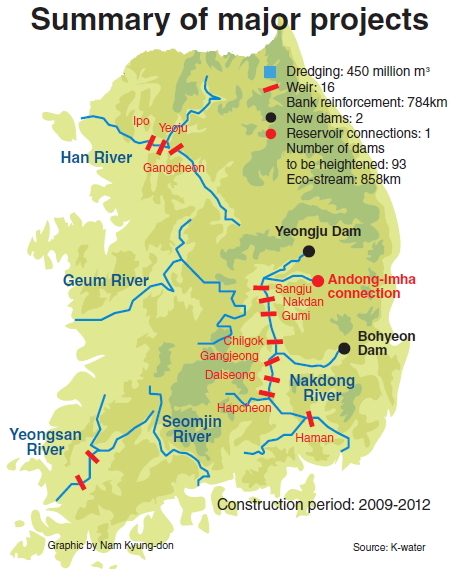 |
These two photos show old and renovated Gyeongcheon Island and its surrounding area on the Nakdong River. (The Korea Herald) |

Challenges in water management
The project was designed to address the significant environmental challenges faced by the nation’s four major rivers. Repeated flooding and droughts have caused death, ecosystem loss and habitat degradation, property damage and forced displacement of people living close to rivers.
The nation’s annual average precipitation is 40 percent higher than the world average. However, the amount of water available per capita in a year is only about 12 percent greater, because two-thirds of the annual rainfall occurs during the rainy season from June to September, and almost no rain occurs in the dry season.
As a result, disasters caused by repeated floods and droughts used to occur almost every year. In addition, the river reaches in Korea are relatively short and channel slopes are steep. Therefore, flooding occurs quickly, peak flood discharges are great, and flow variations are large.
The project was first announced as part of the “Green New Deal” policy, launched by President Lee Myung-bak in January 2009. It was later included in Korea’s five-year national plan released in July 2009. The river restoration project was able to take a systematic and organized approach as the Office of National River Restoration under the Ministry of Land, Transport and Maritime Affairs led the project.
The goals of the project were to restore the nation’s four major rivers ― the Han, Nakdong, Geum and Yeongsan ― and to create water security, flood control and ecosystem vitality. Under these goals, the government developed the project to prevent natural disasters such as floods and droughts, protect the environment and promote historical and cultural tourism.
The project was split further into three sections. The main project was about four rivers’ revitalization. The second was to make improvements to 14 tributaries of the four major rivers. The third was to refurbish other smaller steams.
Action plans to tackle each challenge
A specific action plan was developed to tackle each major challenge. To solve the issue of water shortages, the project built waterways and 16 weirs around four rivers. These 16 weirs are expected to secure 800 million cubic meters of water. Additionally, the construction of three small and medium-sized multipurpose dams is expected to yield another 250 million cubic meters of water.
By dredging riverbeds, the flood water level will decrease, and the water flow capacity will increase significantly. This will significantly reduce annual floods and the damage they cause.
For measures to control floods, the project expanded the water gates of the tributaries, allowing a quick water level decline and fast draining of flood.
In addition, two flood-control areas and three underflow areas of riversides together expanded the flood control capacity up to 920 million cubic meters of water.
Regarding the challenge in water quality and ecological restoration, the project expanded sewage treatment facilities and established green algae reduction facilities.
The government expects by 2012, the water quality of the mainstream will be improve to an average of level two, under which the biochemical oxygen demand is less then 3 ppm.
The project also kept in consideration the life of local residents after the construction. The project built up the riverfront as a multi-purpose to improve the lifestyle of Korean citizens. Bicycle lanes linking the four rivers, amounting to 1,728 km, were created.
Evaluation
It might take longer to see specific benefits from the water management infrastructure project. Some positive data has been released by the government this year. In terms of flood control, a typhoon in June this year was well resisted. From June 22-27, it rained a total national average of 207.7 mm.
This is equivalent to 20 billion tons, reaching 17 percent of the annual rainfall. Despite the concerns about safety on the sites of the four rivers, damage turned out to be meager.
This change was attributed to a lowered flood level achieved from dredging.
The project derived significant economic benefits such as job creation. The Ministry of Employment and Labor said employment effects from the project is equivalent to 7.37 trillion won ($6.8 billion) from 2009 to 2010 for two years, creating job opportunities for 88,400 people.
By Seo Jee-yeon (jyseo@heraldcorp.com)







